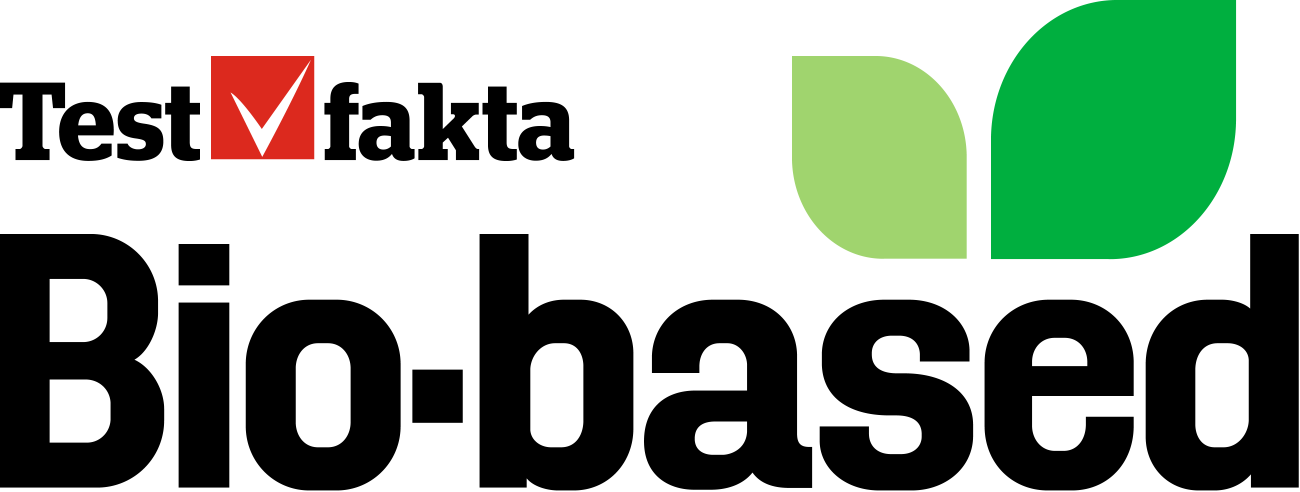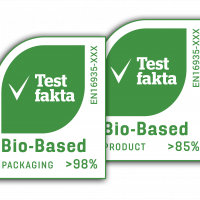One basic criterion for Testfakta Bio-based certification is that the product must contain a high proportion of bio-based content, compared with other, similar products. Another is that it must meet essential environmental and performance requirements.
The minimum percentage of bio-based content required for certification varies according to the product category.
Manufacturer’s details confirmed in analysis
A company registers its interest in certifying a product, and is then responsible for attesting that the product meets the certification criteria. The product also undergoes independent analysis in which its bio-based content is measured. A scientifically based, transparent method is thus used to confirm the information from the manufacturer.
Certification and labelling of product and/or packaging
The company may choose to certify the product only (the contents of any packaging used), the packaging only, or both the product and the packaging. The proportion of bio-based content is specified separately for the various components.

The certification process, step by step:
- Registration of interest
The owner of a product registers interest in certifying it. - Specification of requirements
Based on product type, we inform the owner of specific requirements for its certification, the documentation required, a detailed account of the certification process, and costs. - Certification agreement
The product owner and Testfakta Bio-based sign an agreement on assessment and certification. - Assessment of the product
The documentation is reviewed. The bio-based content is then calculated on the basis of the product’s composition, and the result is verified through technical analysis. The assessment and calculation results are reported to the product owner. - Product labelling
If the product meets the certification requirements, an agreement entitling the manufacturer to label the product as Testfakta Bio-based is signed.
Bio-based content verified in the laboratory
Bio-based products may contain renewable materials only, but usually comprise a mix of renewable and fossil materials. The bio-based content (biomass share) of the product or packaging is calculated on the basis of detailed data on the composition of the product. The biomass proportion calculated is verified and defined by means of technical analysis.
The percentage stated on the label refers to the share of bio-based content. Bio-based products may contain renewable materials only, but usually consist of a mix of renewable and fossil materials. The content of the product is measured and defined by an independent test laboratory. The analysis shows how much of the product content is bio-based, and the number on the label refers to the percentage of bio-based content.
How the technical analysis is done
The bio-based content of a product is verified through technical analysis in a laboratory. This analysis is based on the carbon-14 dating method, which is used for such purposes as determining the age of archaeological finds.
This method determines the total quantity of organic carbon in the product analysed and the bio-based proportion of this carbon. If the measured proportion of bio-based carbon is 100%, it means that 100% of the carbon (in the product) comes from plants or animal by-products. If the proportion of bio-based carbon is found to be 0%, this means that all the organic carbon (in the product) comes from oil or other fossil resources.
Depending on the calculation model, the proportion of bio-based organic carbon is used to verify or certify the bio-based content of a product.
Various calculation models
Products are certified on the basis of different calculation models (standards), depending on the geographic market and recipient (B2C or B2B). Reporting of the proportion of bio-based content conforms to current guidelines and recommendations:
-
For products sold to consumers (Business-to-Consumer, B2C) in the EU, the certification complies with European Standard EN 16935: 2017.
-
For products sold between companies (Business-to-Business, B2B) in the EU, the certification complies with European Standard EN 16848: 2016.
-
For products sold either to consumers or between companies (B2C or B2B) outside the EU, the company chooses whether to base the certification either on one of the above or on the ASTM D6866 standard test method.
Which calculation model (standard) the certification is based on is stated on the label, and the information linked to the product's certification ID.

If you would like to know more about the certification or have other questions, please contact us.





